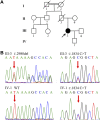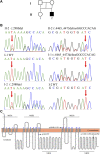Case Report: Three novel pathogenic ABCC2 mutations identified in two patients with Dubin-Johnson syndrome
- PMID: 36092886
- PMCID: PMC9452728
- DOI: 10.3389/fgene.2022.895247
Case Report: Three novel pathogenic ABCC2 mutations identified in two patients with Dubin-Johnson syndrome
Abstract
Background: Dubin-Johnson syndrome (DJS) is a rare autosomal recessive genetic disease which is caused by mutations in the ABCC2 gene; it is characterized by chronic hyperbilirubinemia. Here, we report two pedigrees affected with DJS which were caused by three novel pathogenic ABCC2 mutations. Case summary: The two patients exhibited intermittent low-grade, predominantly conjugated hyperbilirubinemia and showed no other abnormalities. They were diagnosed clinically with DJS. Three novel pathogenic ABCC2 mutations-c.2980delA, c.1834C>T, and c.4465_4473delinsGGCCCACAG-were identified by whole-exome sequencing. These mutations could be responsible for DJS in the two pedigrees. The genetic test confirmed the diagnosis of DJS. Conclusion: These results contributed to the genetic diagnosis of the two patients with DJS and expanded the variant database for the ABCC2 gene.
Keywords: ABCC2; Dubin–Johnson syndrome; hyperbilirubinemia; multidrug resistance-associated protein 2; mutation.
Copyright © 2022 Zhao, Shi, Zhang and Huang.
Conflict of interest statement
The authors declare that the research was conducted in the absence of any commercial or financial relationships that could be construed as a potential conflict of interest.
Figures


Similar articles
-
Clinical characteristics and ABCC2 genotype in Dubin-Johnson syndrome: A case report and review of the literature.World J Clin Cases. 2021 Feb 6;9(4):878-885. doi: 10.12998/wjcc.v9.i4.878. World J Clin Cases. 2021. PMID: 33585635 Free PMC article.
-
A recurrent ABCC2 p.G693R mutation resulting in loss of function of MRP2 and hyperbilirubinemia in Dubin-Johnson syndrome in China.Orphanet J Rare Dis. 2020 Mar 18;15(1):74. doi: 10.1186/s13023-020-1346-4. Orphanet J Rare Dis. 2020. PMID: 32183854 Free PMC article.
-
Mutation analysis of the ABCC2 gene in Chinese patients with Dubin-Johnson syndrome.Exp Ther Med. 2018 Nov;16(5):4201-4206. doi: 10.3892/etm.2018.6682. Epub 2018 Sep 3. Exp Ther Med. 2018. PMID: 30344695 Free PMC article.
-
Urinary coproporphyrins as a diagnostic biomarker of Dubin-Johnson syndrome in neonates: A diagnostic pathway is proposed.Saudi J Gastroenterol. 2023 May-Jun;29(3):183-190. doi: 10.4103/sjg.sjg_480_22. Saudi J Gastroenterol. 2023. PMID: 37313948 Free PMC article. Review.
-
ABCC2/Abcc2: a multispecific transporter with dominant excretory functions.Drug Metab Rev. 2010 Aug;42(3):402-36. doi: 10.3109/03602530903491741. Drug Metab Rev. 2010. PMID: 20082599 Review.
Cited by
-
Dubin-Johnson Syndrome: A Case Report.Cureus. 2023 Mar 14;15(3):e36115. doi: 10.7759/cureus.36115. eCollection 2023 Mar. Cureus. 2023. PMID: 37065356 Free PMC article.
-
Genotype-Phenotype Association in ABCC2 Exon 18 Missense Mutation Leading to Dubin-Johnson Syndrome: A Case Report.Int J Mol Sci. 2022 Dec 18;23(24):16168. doi: 10.3390/ijms232416168. Int J Mol Sci. 2022. PMID: 36555809 Free PMC article.
-
Clinical characteristics and follow-up of a newborn with Dubin-Johnson Syndrome: A clinical case report.Medicine (Baltimore). 2024 Jan 26;103(4):e36991. doi: 10.1097/MD.0000000000036991. Medicine (Baltimore). 2024. PMID: 38277553 Free PMC article.
References
Publication types
LinkOut - more resources
Full Text Sources

